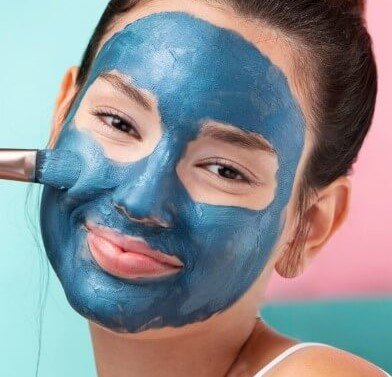Treatment Overview
The Obagi Blue Peel is a medium-depth chemical peel that uses trichloroacetic acid (TCA) combined with a distinctive blue base that allows dermatologists to control depth and ensure even application. It is considered stronger than superficial AHA or BHA peels, making it effective for moderate pigmentation issues, sun damage, and skin aging.
In Korean dermatology clinics, the Obagi Blue Peel is often used for melasma, PIH (post-inflammatory hyperpigmentation), freckles, sunspots, and uneven tone, especially in patients with recurrent or stubborn pigmentation. The peel not only addresses pigmentation but also improves texture, acne scars, and fine lines, making it a rejuvenating as well as depigmenting treatment.
Purpose & Benefits
- Pigment Reduction: Lightens melasma, PIH, freckles, and sunspots.
- Skin Brightening: Creates a clearer, more even complexion.
- Texture Improvement: Smooths rough skin, reduces pores and acne scars.
- Anti-Aging: Diminishes fine lines and sun-related skin damage.
- Controlled Depth: Blue base allows Korean dermatologists to adjust intensity safely for Asian skin.
Ideal Candidates
Obagi Blue Peel in Korea is recommended for:
- Adults with moderate pigmentation not fully improved by superficial peels.
- Patients with stubborn melasma or PIH.
- Individuals with sun damage, freckles, or solar lentigines.
- Adults seeking both pigment correction and anti-aging benefits.
- Patients who can tolerate moderate downtime for stronger results.
Possible Risks & Complications
- Redness & Peeling: Stronger than mild peels; visible peeling for 5–10 days.
- Dryness & Tightness: Common during recovery.
- Stinging or Burning: Temporary during application.
- Rare Risks: PIH rebound if sun care is neglected, especially in Asian skin.
- Downtime: More noticeable peeling compared to lighter acid peels.
Surgical Techniques Used
- Trichloroacetic Acid (TCA): Medium-depth peel for pigment and texture.
- Blue Base: Provides even application and visual depth control.
- Layered Application: Number of coats controls penetration depth.
- Combination Protocols: Sometimes paired with Pico lasers or brightening drips post-healing.
- Protocol: Typically 1–2 peels, spaced 6–12 months apart, with maintenance skincare.
Recovery & Aftercare
- Immediately: Burning or stinging sensation, redness, and tightness.
- 2–3 Days: Skin darkens slightly, begins to feel tight.
- 3–7 Days: Visible peeling and shedding of pigmented layers.
- 1–2 Weeks: Smoother, clearer, more even-toned skin.
Aftercare Tips:
- Use SPF 50+ sunscreen daily; avoid all sun exposure during peeling phase.
- Apply only dermatologist-recommended moisturizers and barrier creams.
- Avoid exfoliants, acids, or retinoids until fully healed.
- Do not pick at peeling skin.
- Maintain hydration for barrier recovery.
Results & Longevity
- After 1 Peel: Noticeable improvement in pigmentation and skin texture within 2 weeks.
- After 1–2 Peels: Significant fading of melasma, PIH, freckles, and sun damage.
- After 3–6 Months: Long-lasting results with proper maintenance skincare.
- Long-Term: Annual or bi-annual treatments may be recommended for persistent pigmentation.
Treatment Process in Korea
1. Consultation & Skin Analysis
- Dermatologist evaluates pigmentation depth and overall skin health.
- Obagi Blue Peel usually recommended for patients needing medium-depth results.
2. Preparation
- Skin cleansing and degreasing.
- Application of protective measures for sensitive areas.
3. Obagi Blue Peel Session
- Step 1: Application of blue TCA solution in layers.
- Step 2: Dermatologist monitors frosting and depth control.
- Step 3: Soothing cream applied post-procedure.
- Duration: 20–30 minutes (mask remains for several hours).
4. Post-Treatment Care in Clinic
- Sunscreen and protective cream applied.
- Aftercare instructions provided.
5. Follow-Up
- Typically 1–2 sessions, spaced months apart.
- Maintenance with brightening creams or Pico laser sessions.
Unique Korean Advantages
- Tailored for Asian Skin: Korean dermatologists use adjusted concentrations to reduce PIH risk.
- Combination Care: Often paired with Pico lasers, whitening drips, or serums for faster results.
- Barrier-Focused Aftercare: Strong emphasis on hydration and sun protection during recovery.
- Holistic Pigment Programs: Peel is integrated into multi-step depigmentation packages.
Cost Range (Estimated)
- Single Peel Session (Full Face): USD 300 – 600
- Full Program (Peel + Follow-Up Care + Maintenance Creams): USD 600 – 1,200
- Premium Program (Obagi Blue Peel + Laser + Whitening Drips): USD 1,500 – 2,500
Additional Costs:
- Consultation: USD 20 – 50
- Add-ons (Whitening drips, Vitamin C, TXA infusions): USD 100 – 200
- Boosters (PRP, Rejuran, Exosomes): USD 200 – 600
- LED or Cooling Mask Therapy: USD 30 – 80
Popular Clinics in Seoul
- Oracle Dermatology: Obagi Blue Peel for melasma and PIH.
- Banobagi Dermatology: Blue Peel for stubborn pigmentation + laser care.
- Renewme Skin Clinic: Obagi Blue Peel with whitening infusions.
- View Plastic & Dermatology: Blue Peel for pigment + rejuvenation.
- Chaum Anti-Aging Center: Premium Blue Peel programs with regenerative boosters.




